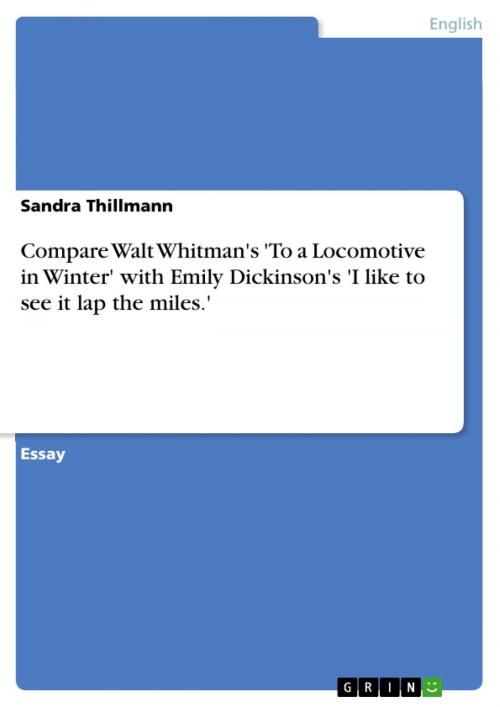Compare Walt Whitman's 'To a Locomotive in Winter' with Emily Dickinson's 'I like to see it lap the miles.'
Nonfiction, Entertainment, Drama, Anthologies| Author: | Sandra Thillmann | ISBN: | 9783638620291 |
| Publisher: | GRIN Verlag | Publication: | March 30, 2007 |
| Imprint: | GRIN Verlag | Language: | English |
| Author: | Sandra Thillmann |
| ISBN: | 9783638620291 |
| Publisher: | GRIN Verlag |
| Publication: | March 30, 2007 |
| Imprint: | GRIN Verlag |
| Language: | English |
Essay from the year 2006 in the subject American Studies - Literature, grade: 1,0, University of Marburg, course: Introduction to the study of English Literature, 0 entries in the bibliography, language: English, abstract: 'To a Locomotive in Winter', written by Walt Whitman, is about a locomotive, that is described as very strong and powerful in a positive way. In the poem it becomes clear that the speaker is a supporter of the technological progress of America, represented by the locomotive, because he tries to establish a connection between poetry and science. Emily Dickinson's 'I like to see it lap the Miles' is also about a locomotive. Again poetry and science are linked in a certain way but in contrast to Whitman her poem has some negative connotations. So maybe the speaker is no supporter of America's technological progress or at least he is afraid of the future fortune.
Essay from the year 2006 in the subject American Studies - Literature, grade: 1,0, University of Marburg, course: Introduction to the study of English Literature, 0 entries in the bibliography, language: English, abstract: 'To a Locomotive in Winter', written by Walt Whitman, is about a locomotive, that is described as very strong and powerful in a positive way. In the poem it becomes clear that the speaker is a supporter of the technological progress of America, represented by the locomotive, because he tries to establish a connection between poetry and science. Emily Dickinson's 'I like to see it lap the Miles' is also about a locomotive. Again poetry and science are linked in a certain way but in contrast to Whitman her poem has some negative connotations. So maybe the speaker is no supporter of America's technological progress or at least he is afraid of the future fortune.















